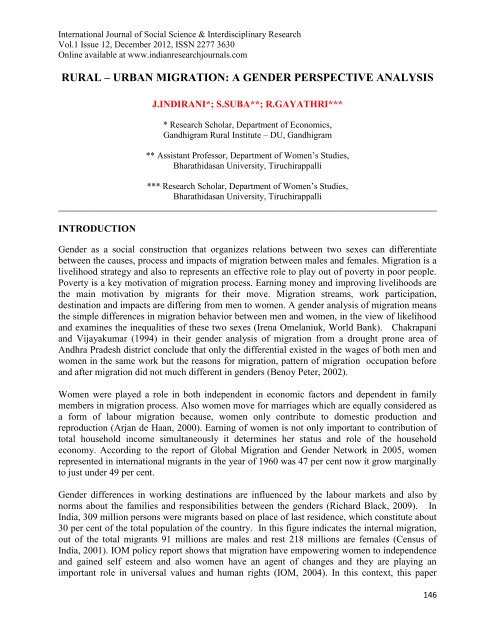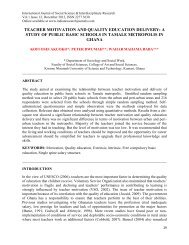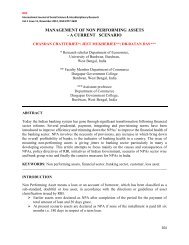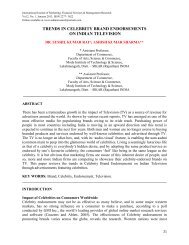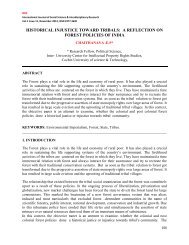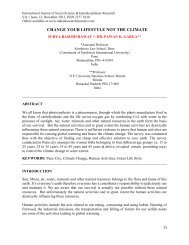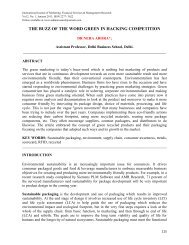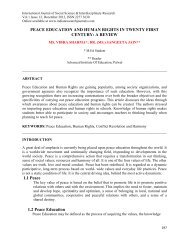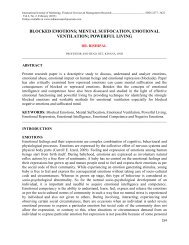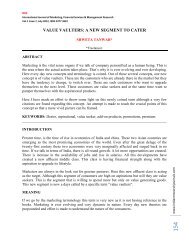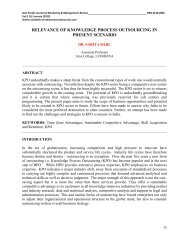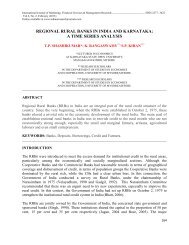rural â urban migration: a gender perspective analysis
rural â urban migration: a gender perspective analysis
rural â urban migration: a gender perspective analysis
You also want an ePaper? Increase the reach of your titles
YUMPU automatically turns print PDFs into web optimized ePapers that Google loves.
International Journal of Social Science & Interdisciplinary Research<br />
Vol.1 Issue 12, December 2012, ISSN 2277 3630<br />
Online available at www.indianresearchjournals.com<br />
RURAL – URBAN MIGRATION: A GENDER PERSPECTIVE ANALYSIS<br />
J.INDIRANI*; S.SUBA**; R.GAYATHRI***<br />
* Research Scholar, Department of Economics,<br />
Gandhigram Rural Institute – DU, Gandhigram<br />
** Assistant Professor, Department of Women‟s Studies,<br />
Bharathidasan University, Tiruchirappalli<br />
*** Research Scholar, Department of Women‟s Studies,<br />
Bharathidasan University, Tiruchirappalli<br />
______________________________________________________________________________<br />
INTRODUCTION<br />
Gender as a social construction that organizes relations between two sexes can differentiate<br />
between the causes, process and impacts of <strong>migration</strong> between males and females. Migration is a<br />
livelihood strategy and also to represents an effective role to play out of poverty in poor people.<br />
Poverty is a key motivation of <strong>migration</strong> process. Earning money and improving livelihoods are<br />
the main motivation by migrants for their move. Migration streams, work participation,<br />
destination and impacts are differing from men to women. A <strong>gender</strong> <strong>analysis</strong> of <strong>migration</strong> means<br />
the simple differences in <strong>migration</strong> behavior between men and women, in the view of likelihood<br />
and examines the inequalities of these two sexes (Irena Omelaniuk, World Bank). Chakrapani<br />
and Vijayakumar (1994) in their <strong>gender</strong> <strong>analysis</strong> of <strong>migration</strong> from a drought prone area of<br />
Andhra Pradesh district conclude that only the differential existed in the wages of both men and<br />
women in the same work but the reasons for <strong>migration</strong>, pattern of <strong>migration</strong> occupation before<br />
and after <strong>migration</strong> did not much different in <strong>gender</strong>s (Benoy Peter, 2002).<br />
Women were played a role in both independent in economic factors and dependent in family<br />
members in <strong>migration</strong> process. Also women move for marriages which are equally considered as<br />
a form of labour <strong>migration</strong> because, women only contribute to domestic production and<br />
reproduction (Arjan de Haan, 2000). Earning of women is not only important to contribution of<br />
total household income simultaneously it determines her status and role of the household<br />
economy. According to the report of Global Migration and Gender Network in 2005, women<br />
represented in international migrants in the year of 1960 was 47 per cent now it grow marginally<br />
to just under 49 per cent.<br />
Gender differences in working destinations are influenced by the labour markets and also by<br />
norms about the families and responsibilities between the <strong>gender</strong>s (Richard Black, 2009). In<br />
India, 309 million persons were migrants based on place of last residence, which constitute about<br />
30 per cent of the total population of the country. In this figure indicates the internal <strong>migration</strong>,<br />
out of the total migrants 91 millions are males and rest 218 millions are females (Census of<br />
India, 2001). IOM policy report shows that <strong>migration</strong> have empowering women to independence<br />
and gained self esteem and also women have an agent of changes and they are playing an<br />
important role in universal values and human rights (IOM, 2004). In this context, this paper<br />
146
International Journal of Social Science & Interdisciplinary Research<br />
Vol.1 Issue 12, December 2012, ISSN 2277 3630<br />
Online available at www.indianresearchjournals.com<br />
reviews the <strong>gender</strong> issues of migrant women and their employment status and issue faced by<br />
them. This paper particularly focusing <strong>gender</strong> issues of migrant women both organized and<br />
unorganized sector.<br />
Migration and Employment Status of Women in India<br />
Trade liberalization and new economic policies have emerged <strong>gender</strong> specific demand for labour<br />
market. So, the <strong>migration</strong> streams are groups or jointly with their families to cash–in–<br />
opportunity. As discussed above, the global shift is the cause of more service - intensive<br />
economy and labour–intensive manufacturing industries have increased demand for female<br />
labour (Skeldon.R, 1997). In this context, increase in the female <strong>migration</strong> for the reason of<br />
trans-globalization of economies, which has created demand for laborer in low paying services<br />
sector (Sassen, 2003). Some of the push factors of women migrants are marriage, education,<br />
social tension, lack of employment, loss of land, family problems and so on (Sundari.S, 2005).<br />
Migrant labour markets are segmented and highly <strong>gender</strong>ed, in terms of the capacity to earn as<br />
well as the conditions of work. Female <strong>migration</strong> began to be employed more in the 1980‟s and<br />
especially mid-1990s onwards. In India, between 1983 and 1999, the per cent of female workers<br />
has gone up from 80 to 87 per cent. According to Register General of India, the work participate<br />
rate for women was 25.68 percent in 2001. Work participate rate for women in <strong>rural</strong> areas was<br />
30.98 per cent as compared to 11.55 percent in the <strong>urban</strong> areas in the same year. In this view, in<br />
the <strong>rural</strong> areas, women are mainly involved as cultivators and agricultural labourers. In the <strong>urban</strong><br />
areas, almost 80 per cent of the women workers are working in the unorganized sectors like<br />
household industries, petty trades and services, buildings and construction (Veenu Nirmal,<br />
2007). By the way, the important reasons for this on demand side as well as supply side. The<br />
demand side, in <strong>urban</strong> area most of the women are working outside of the house, single working<br />
men and women are depend upon on domestic work of household chores, cheap labour and also<br />
the cultural framing of <strong>gender</strong> rules are the main reason for increasing work participation rate in<br />
domestic work in India. At the same time, the supply side, the training is not required to<br />
domestic work, low educational qualities, a readiness to work for low wages and lower status<br />
jobs are the factors influenced female workers in this market (Ravinder Kaur, 2006). At the same<br />
time, <strong>gender</strong> inequality can penetrate the decision, process and impacts of <strong>migration</strong>, as well as<br />
the networks and support systems that play an important role at all stages of <strong>migration</strong> (UNGA,<br />
2004). Particularly, in domestic sector the demand for women is grown continuously. In <strong>urban</strong><br />
areas, only 1.4 per cent of male workers are in domestic work as against 15 per cent for female<br />
workers. On the contrary, in <strong>rural</strong> areas 1.8 percent of female workers are in domestic workers.<br />
In terms of employment, construction sector is another largest sector to providing employment<br />
opportunities in India. Most of the workers in construction sector are migrant labour. In this<br />
sector, women occupy more than one percentage, yet, the division of labour is <strong>gender</strong>ed.<br />
Masonry is a dominated person in this sector, this roles play only to men not for women. Women<br />
carries head loads of brick, sand, stone cement and water to the mason. The wages also less<br />
compared to men. On the site, women are paid Rs. 60-70 per day while men are paid Rs. 100-<br />
175. Manson earn up to Rs. 175-250. The work place is unsafe.<br />
A recent study of International labour Organization provides a report that 165 out of every 1000<br />
workers have injured in this job (Sudhershan Rao Sarde). While they are found opportunity in<br />
147
International Journal of Social Science & Interdisciplinary Research<br />
Vol.1 Issue 12, December 2012, ISSN 2277 3630<br />
Online available at www.indianresearchjournals.com<br />
different sectors of the industry, in textile industry they are primarily employed as ‟checkers‟ and<br />
„packers‟ in the stitching units, recently also as power-table tailors (Geert De Neve, 2004). By<br />
the way, in service sector women play an important role to play <strong>gender</strong> based activity is nursing.<br />
Service sector opportunities are limited. Yet, nursing is inextricably intertwined with dominant<br />
conception of <strong>gender</strong> roles (Sreelekha Nair, 2011). Women are not only following their father<br />
and husbands. They migrate in their own capacities as workers. Majority of the workers are<br />
housemaids, nurses, entertainers and factory workers. For this view, the employment status of<br />
the women dependent on age, marital status, education, economic status, location of residence<br />
and social group are the main factors are affecting employment status of women in India.<br />
Age is one of the important factors to determine the employment status of female workers. If the<br />
age is increased the chances of getting employment opportunities is also high. Compared to the<br />
lower age group (15-24) migrant women, those in higher age groups (25-59) have greater<br />
probability of getting employment opportunities in India. Further, in female migrants, single<br />
women have a greater chance of getting employment opportunity compared married women.<br />
Another category of castes/groups considered as women belonging lower category have a greater<br />
probability of getting employment opportunities. Particularly, migrant women in Scheduled<br />
Tribe have 2.6 times higher probability of getting employment opportunities compared to<br />
General category in employment. Yet, the <strong>migration</strong> has a positive impact on migrant women<br />
other than non-migrant workers. Simultaneously, education is not a significant factor to<br />
determine the employment status of women in India. Because, majority of the women workers<br />
are concentrating a primary-related activities (80 per cent), they do not require much skill and<br />
education. Especially economic status is an important factor to determining the employment<br />
status.<br />
Generally, the lower status of women migrants find more employment opportunity belonging to<br />
the higher economic status. At the same time, women belonging <strong>urban</strong> areas have lower chance<br />
to getting employment opportunities compared to <strong>rural</strong> women (Remya Prabha.G, 2011).<br />
Diversification of economic opportunities for women workers also need not necessarily have positive<br />
implications for their economic wellbeing.<br />
Issues of Migrant Women Workers<br />
In the Indian context, women are suffered more in bad working conditions, long hours of work,<br />
low wages, over-work and discrimination. They are exploited for the sexual harassment and<br />
exploitation (Acharya, 1987 and Saradamoni, 1995). The housemaids are especially vulnerable<br />
because, they work in private houses and little inspection. The problems like sexual harassment,<br />
rape, non-repayment or underpayment of wages, verbal/physical abuse and so on (Nana Oishi).<br />
Meanwhile, men migrate and women left behind, they have a greater role in house-hold decision<br />
making process. They gain remittances, however suffered a lot such as increase work load, stress<br />
and vulnerability (Susie Jelly, 2003).<br />
In industrial sector, women migrant workers have not been able to enjoy better jobs within the<br />
industry and they have no scope for upward mobility. The opportunities for wider skill<br />
acquisition, the chances of promotion to contractor, supervisor or manager, it is only possible for<br />
men not for women workers (Filippo Osella and Katy Gardner, 2004). Further, lodging facility is<br />
an important problem for the migrant nurses. Hostels are provided to the hospitals are crowded<br />
148
International Journal of Social Science & Interdisciplinary Research<br />
Vol.1 Issue 12, December 2012, ISSN 2277 3630<br />
Online available at www.indianresearchjournals.com<br />
and also the accommodation providing nearby hospitals. Because, the shortage of nurses they<br />
can be asked to duty in night hours. Such overtime is not compensated to many hospitals<br />
(Sreelekha Nair, 2011).<br />
The migrants are facing number of problems at their native place and destination. They are<br />
withdrawing child from school, reduction in food consumption, depletion in mulch animals,<br />
increased debt, increased intensity of <strong>migration</strong>, unpaid hospital bills, increase of slums, increase<br />
of health problem due to living in slums, increase of pollution, low wages, increase of crimes and<br />
suicides, and in-secured life (Lal B. Suresh et al). In another point of view, females in the<br />
families, whose males migrate to the city, they have to bear heavy burdens within the family, and<br />
the greater insecurity of the woman at home. The kind of work that the women of these families<br />
can gets is low paid, dull, repetitive and hazardous. The females suffer from inadequate and<br />
insecure income, uncertainty of life and exploitation, working conditions, social security, etc.<br />
(Surinder Jetlay, 1987). Health is an important determinant of <strong>migration</strong> by the poor and adverse<br />
effect of women workers. In developing countries, disease (malaria, TB and particularly HIV) is<br />
affecting the migrant workers.<br />
In the study of engineering industry in Coimbatore reflect the proportion of women workers are<br />
consuming liquor was higher engaged in work in the case of pump industrial units. Further, the<br />
workers in informal sector did not take adequate nutritious food for maintain their health. The<br />
migrant workers are affecting the heat generated by the boilers causes‟ asthma, lung diseases,<br />
and breathing problems in foundry industrial units. Body pains and muscular problems are<br />
affected specifically to screen printing units (Naagarajan R, 2010). The literature on <strong>migration</strong><br />
and social protection records how the varied lives and livelihoods of migrants do not suit for the<br />
developmental programmes and government relief schemes. Because, these women led mobile<br />
lives they cannot include listed as household heads, or even members of the households in which<br />
they are temporarily reside, and are missing from official lists and NGO „baselines surveys of the<br />
poor‟ (Janet Seeley et al, 2006).<br />
Conclusion<br />
Above all concludes that changes in labour demands, the increasing vulnerability of women, the<br />
conflicting social demands and the economic compulsions may all be the critical factors<br />
affecting the lives of migrant women. Gender-based discrimination in the labour market is not merely<br />
unjust for women workers; it is also economically harmful to the country. From the <strong>perspective</strong> of the<br />
wellbeing of migrant women workers, the consequences are apparent. Working conditions, types of<br />
employment, and wage levels clearly have an impact on the wellbeing levels of migrant women workers.<br />
The importance of social welfare in eradicating unequal <strong>gender</strong> relations and promoting the status of<br />
women is apparent from the state of affairs in developed countries; however, it is imperative to recognize<br />
that implementing legislative and public policy changes does require <strong>gender</strong>-conscious planning.<br />
149
International Journal of Social Science & Interdisciplinary Research<br />
Vol.1 Issue 12, December 2012, ISSN 2277 3630<br />
Online available at www.indianresearchjournals.com<br />
References:<br />
1. Irena Omelaniuk,<br />
“Gender, Poverty Reduction and Migration”, World Bank.<br />
2. Benoy Peter, 2002,<br />
“Measuring inter and intra-Gender differentials in Migration”, International Institute for<br />
Population Sciences, Mumbai.<br />
3. Arjan de Haan, 2000,<br />
“Migrants, Livelihoods and Rights: The Relevance of Migration and Development<br />
Policies”, Social Development Working Paper No. 4.<br />
4. Skeldon R, 1997, “Rural<br />
Urban-Migration and its Implication for Poverty Alleviation”, Asia Pacific Population<br />
Journal, Vol. 12, No. 1.<br />
5. Sassen S, 2003,<br />
“Globalization and its Discontent-Essays on the New Mobility of People and Money”,<br />
The New York Press, New York.<br />
6. Sundari S, 2005,<br />
“Migration as a Livelihood Strategy-A Gender Perspective”, Economic and Political<br />
Weekly, Vol.40, No. 22-23, May 28-June 10, pp. 2295-2303.<br />
7. Veenu Nirmal, 2007,<br />
Migrant Labour in India (An Explorative Study), Universal Voice Publication, new<br />
Delhi.<br />
8. Ravinder Kaur,<br />
“Migrating for Work: Rewriting Gender Relations “, Meenakshi Thapan (eds), Women<br />
and Migration in Asia, Volume 2, Sage Publications, New Delhi, pp.192-213.<br />
9. UNGA (UN General<br />
Assembly), 2004, “World Survey on the role of women in development”, Report of the<br />
Secretary General, addendum on “women and international <strong>migration</strong>”, September, New<br />
York.<br />
10. Nana Oishi, 2002,<br />
“Gender and Migration: An Integrative Approach”, Working Paper 49, The Centre for<br />
Comparative Im<strong>migration</strong> Studies (CCIS), University of California, San Deigo.<br />
11. Susie Jelly et al., 2003,<br />
“Gender and Migration - Overview Report”, BRIDGE Development and Gender,<br />
Institute of Development Studies. www.bridge.ids.ac.uk/reports/pdf<br />
12. Sudarshan Rao Sarde,<br />
“Migration in India-Trade Union Perspective in the context of Neo-Liberal Globalization.<br />
www.Migrant_workers_in_India.pdf<br />
13. Geert De Neve, 2004,<br />
“Expectations and rewards of Modernity: Commitment and mobility among <strong>rural</strong><br />
150
International Journal of Social Science & Interdisciplinary Research<br />
Vol.1 Issue 12, December 2012, ISSN 2277 3630<br />
Online available at www.indianresearchjournals.com<br />
migrants in Tirupur, Tamil Nadu”, Filippo Osella and Katy Gardner (eds), Migration,<br />
modernity and social transformation in South Asia, Sage Publications, New Delhi,<br />
pp.251-279.<br />
14. Census of India, 2001,<br />
India D-Series, Migration tables, Registrar General and Census Commissioner, India.<br />
15. International Organization<br />
of Migration (IOM), 2004, “Towards an IOM Strategy-Migration and Development”,<br />
Conference Room Paper /12, 88 th Session of the Council, Geneve, 30 November-3<br />
December.<br />
16. Surinder Jetlay, 1987,<br />
“Impact of Male Migration on Rural Females”, Economic and Political Weekly, October<br />
31, pp.47-53.<br />
17. Sreelekha Nair, 2011,<br />
“Multiple Identities and Migratory Dynamics of Nurses”, Irudaya Rajan. S (eds),<br />
Migration, Identity and Conflict-India Migration Report 2011, Routledge Publication,<br />
New Delhi, pp. 203-218.<br />
18. Remya Prab.G, 2011,<br />
“Migration and Female Employment in India: Macro Evidence from NSSO Data”,<br />
Irudaya Rajan. S (eds), Migration, Identity and Conflict-India Migration Report 2011,<br />
Routledge Publication, New Delhi, pp. 183-202.<br />
19. Lal B. Suresh et al., 2007,<br />
“Women Labour Migration: An Empirical Investigation”, Southern Economist,<br />
December 15, pp.33-36.<br />
20. Naagarajan R, 2010,<br />
“Social Security of Informal Sector Workers in Coimbatore District, Tamil Nadu”, The<br />
Indian Journal of Labour Economics, Vol.53, No. 2, pp. 359-380.<br />
21. Janet Seeley et al.,<br />
2006,”Just Surviving or Finding Space to Thrive? The Complexity of Internal Migration<br />
of Women in Bangladesh”, Meenakshi Thapan (eds), Women and Migration in Asia, Vol.<br />
2, Sage Publications India Pvt Ltd, New Delhi, pp.171-191.<br />
151


